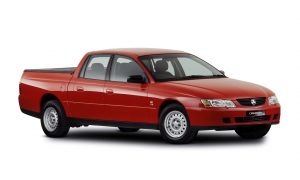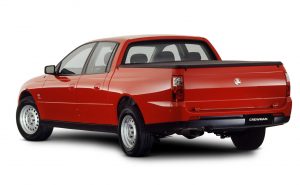Recalls: Holden VY Crewman
Overview
Manufacturers, or importers, issue recalls for defects or faults which have the potential to cause injury. Generally, manufacturers will inform the original buyers if their vehicle is subject to a recall and of the steps required to remedy the defect or fault. Please note that the recalls below (if any) are for Australian-delivered vehicles only. Furthermore, the number of recalls should not be taken as an indication of a model’s reliability or its safety more generally.
Recalls: Holden VY Crewman
- In April 2004, a recall was issued for Holden VY Crewman models built from 5 May 2003 and 9 October 2003 for compliance plates which stated incorrect model designations and approval numbers (PRA 2004/6954).
- In May 2004, a recall was issued for Holden VY Crewman models built from 26 August 2002 and 2 September 2003 due to the possibility of the power steering cooler hose rupturing during cornering (PRA 2004/6978).
- In May 2004, a recall was issued for Holden VY Crewman models manufactured in the first two (2) weeks of May 2004 due to some driver’s seat having been manufactured with incomplete riveting and welding between the seat track and the mounting foot on the front right hand side (PRA 2004/7011).
- In March 2006, a recall was issued for Holden VY Crewman models manufactured from 1 April 2003 to 2 December 2005 that were fitted with front seat-mounted side airbags. The electrical earth wire fitted underneath either front seat could become detached, potentially causing an electrostatic charge to transfer through the seat and causing unintended deployment of the front side airbag when the vehicle was stationary and while an occupant was exiting one of the front seats (PRA 2006/8380).
- In April 2006, a recall was issued for Holden VY Crewman SS variants due to an incorrect ‘Gross Vehicle Mass’ printed on the compliance plate; this could lead to incorrect calculation of the vehicle’s towing capacity (PRA 2006/8450).
Problems and faults: Holden VY Crewman
Overview
This section identifies potential problems, causes and fixes based on the experiences of owners and repairers, online sources and technical service bulletins. This information is provided solely for reference purposes and AustralianCar.Reviews recommends that only properly qualified persons carry out repairs or modifications. Furthermore, the number of items below should not be taken as an indicator of a model’s reliability or the frequency with which they may occur.
To report a problem or fault to the AustralianCar.Reviews team, please use the Contact Us form. Note that AustralianCar.Reviews does not offer advice on automotive problems or disputes; such enquiries will not receive a reply. For vehicles purchased from dealers after 1 January 2011, please see our Australian Consumer Law fact sheet.
V6 Engines
- When idling, the belt may squeal or squeak because the power steering pump pulley hub was not pressed sufficiently onto the power steering pump.
- There may be an oil leak on the front edge of the timing cover next to the oil filter due to insufficient surface area for one of the retaining bolts for the oil filter adaptor. A revised oil filter adaptor was released in mid-2004.
VY Crewman: LS1 V8 engines
Overview
With the exception of the early 5.7-litre LS1 V8 engines, General Motors’ LS V8 engines are regarded as being generally reliable. However, they may experience the problems described below.
Hydraulic lifter failure
For GM’s LS V8 engines, the hydraulic lifters may fail due to:
- A failed plunger within the lifter itself. When the plunger fails, it cannot maintain oil pressure and remains in a collapsed state – the lifter therefore cannot take up valve lash such that a tapping noise is heard that increases in volume and frequency with engine speed;
- The spring mechanism jamming – this is more common in older engines;
- Inadequate lubrication of the lifter roller wheel surface causing friction on the lobe (this generally results in a squeaking noise);
- Softened valve springs which also require replacement; or,
- Worn lifter buckets.
A failed hydraulic lifter can bend the pushrods which can then fall out of the space between the rocker arm and the top of the lifter. Once a pushrod falls out of that space, it may cause broken rocker arms, broken valves, cracked heads, a damaged cam or total engine failure.
It is recommended that the lifters be replaced every 100,000 kilometres, though failure of the hydraulic lifters is more common in engines with high-lift camshafts because higher spring pressure are required to prevent valve float, putting extra pressure on the lifter. Replacing the lifters requires that the cylinder heads be removed such that new head gaskets and head bolts are required.
Hydraulic lifter noise
From cold start-up, the hydraulic lifters may make a tapping noise. The most common cause of hydraulic lifter noise is particles in the engine oil becoming jammed between the lifter plunger and the lifter body, causing the plunger to become stuck down. The clearances between the plunger and body of a hydraulic lifter can be as little as 3 microns (0.003 mm) such that any particle larger than this in the oil can jam the lifter plunger in its body.
Lifter noise may also be caused by aeration of engine oil in the lifter’s pressure chamber since this increases valve closing velocity. Aeration of engine oil may be caused by:
- air in the higher pressure chamber of the lifter affecting valvetrain lash;
- air that is ingested into the lifter during a cold start due to a suction side leak at the oil pump or oil pump pick-up tube O-ring; or,
- low oil levels and high engine speeds.
Once air gets into the high pressure chamber, it will be slowly expelled through the narrow clearance of the plunger and body.
Rocker bearing failure
The rocker bearings – which sit on top of the valve train and transfer energy from the pushrod to the valve – can develop a sideways slop which can damage the valve tops, the rocker or valve springs. Furthermore, the rocker bearings can split such that the needle bearings fall out and end up in the oil pan.
Trunion bearing upgrade kits can be installed in the factory rockers which reduce sideways movement and provide a better range of vertical movement. Alternatively, after-market roller rockers can be installed which have better geometry than the standard rockers and control the valve more precisely via the centre of the valve tip.
Valve spring failure
The LS engine has ‘beehive’, single valve-type valve springs (as opposed to a dual valve spring which has a smaller spring inside the primary spring) and, in rare cases, the valve spring may break at its top where the coils are tightly wound. If a single valve-type valve spring breaks, it is common for the valve to be dropped, causing significant engine damage; sometimes, however, the valve may be held up by the valve locks when the spring is breaks. Symptoms of broken valve spring include:
- Engine vibrations;
- Loss of power beyond 4000 rpm;
- Misfire under load; and,
- Constant misfire.
If the vehicle is driven with a broken valve spring, a valve may come into contact with the piston, causing the valve to be bent. Furthermore, if the valve head breaks off, the engine will seize. To fix a failed valve spring, the cylinder heads need to be removed so that a new valve, head gasket and head bolts can be fitted.
For durability, it is recommended that high rpm are avoided when the engine is cold.
LS1 V8 engines: other problems and faults
- A rough idle, high-pitched hissing noise and ‘check engine’ light illuminating may be due to the PCV (positive crank case ventilation) pipe deteriorating. A revised PCV pipe was subsequently released.
- For VY.II Crewman models manufactured up to late 2003, the front exhaust pipe heat shields could rattle if the internal insulator pads became detached.
Models with V8 engines
- Steering rack boots may be damaged by excessive heat from the exhaust system; revised silicone steering rack boots were subsequently released.
- For V8 manual models, a loud knocking noise from the rear during hard acceleration may be due to the rear cross-member insulators missing. As a result, the cross-member would knock against the rear floor area.
Transmissions
- The gearshift lever could rattle due to excessive clearances in the remote shifter linkages; a revised remote shifter was introduced in late 2003.
- For models with the V8 engines, it may be difficult to engage gears and the clutch pedal may feel soft and/or have a low disengagement point due to a chemical reaction between the clutch fluid and clutch slave cylinder housing (which produces a gas in the hydraulic system); a revised clutch slave cylinder was released in late 2003.
Problems and faults: Holden VY Crewman
- A shudder through the steering wheel during low-speed manoeuvres may be rectified by fitting a longer high-pressure power steering line which ran from the power steering rack, was routed and secured in front of the engine, and then continued to the power steering pump.
- The front sway bar links are rubber mounted to the strut housings – these rubbers could squash and split. New, harder rubbers were introduced in early 2003.
- Clunking noises from the front suspension when changing direction may be attributable to bent tie-rod pins.
- For models manufactured from January 2003 to July 2003, a faulty low-speed engine fan relay may cause the fan to remain on even after the ignition is switched off.
- Pressing the horn pad may activate the top radio buttons (mode and mute) due to incorrect assembly reducing clearances between the horn pad and the switches. Assembly procedures were revised in late 2002.
- The fuel gauge may be inaccurate for readings below one-quarter of a tank – a revised fuel gauge calibration was introduced in late 2003 for this problem. Alternatives causes, however, include a bent fuel float and faulty sender unit.
- A thudding or knocking noise may be heard when the cruise control is activated or deactivated if there is insufficient clearance between the cruise control module and the mounting bracket under the bonnet. In mid-2004, a washer was fitted to increased clearance between the module and the bracket.
- Electrical interference may prevent the central locking system from responding to signals from the key fob.
- The door locks may intermittently stop locking or unlocking due to insufficient tolerances in the door lock mechanism; mechanisms with modified operating clearances were introduced in early 2004.
- The Blaupunkt clock may lose time and the CD player may not eject – software updates were released in late 2003 to fix these problems. The CD player may also display error messages, particularly with burnt CDs; resetting the CD player by disconnecting the battery, waiting for a few minutes and then reconnecting may fix the problem.
- The glove box lid may become distorted; a revised glove box lid was introduced in early 2003 with added ribs and which was manufactured from less heat-sensitive material.




